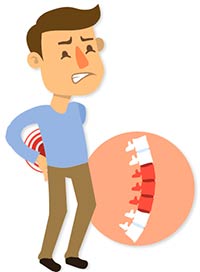
Backaches seem to be as common as the cold. They can be disabling, causing you to miss work and to be absent from your own life.
Sometimes the cause is obvious, such as an injury. Other times, the cause is mysterious and the cure is elusive. Anyone, even children – think about those heavy book bags – can suffer from back pain, but it tends to be more prevalent in older people. Other risk factors include: poor physical fitness, extra weight, heredity, an accident, diseases such as cancer or arthritis or your job. How do these affect your back? Here are some common scenarios.
- Physical activity builds muscles. If you are sedentary, your muscles atrophy and are unable to help support your spine. Activities such as walking or practicing simple yoga or strength exercises can build the support your spine needs.
- If you are overweight, those extra pounds can stress your back. It can be hard to lose weight, but doing so can make a big difference.
- Genetics can be at fault. Certain diseases, such as ankylosing spondylitis, are thought to have a genetic factor at work.
- An accident of any sort may result in back pain.
- Certain cancers can involve the spine and should be treated by a physician.
- Your job can affect your back in a number of ways. A desk job may encourage bad posture, while a physical job that requires heavy lifting can place extra strain on back muscles.
First Try Physical Therapy
If your back pain does not respond to over-the-counter medicines or if it lingers, start with an appointment with your primary care physician. He will likely refer you to a physical therapist. PTs are highly educated about the way your body works and, in many cases, can reduce or eliminate the need for pain medication while improving mobility. The therapist will assess you to understand your issues and will create a personalized plan to correct them. Physical therapists can be found in many medical settings, including hospitals, private practices and home health care services.
If physical therapy fails to help, there are other options. These include chiropractic care, injections and, in a small percentage of cases, surgery.
Chiropractors Adjust Your Spine
Lots of people go to the chiropractor for an adjustment at the first twinge of back pain. Chiropractic care is convenient, not invasive, does not involve medications and often provides near-immediate relief. Chiropractors use a variety of techniques to manipulate the joints. Some use only their hands; others use machines. There are chiropractors who perform gentle adjustment, while others use quick, firm motions.
Dr. Matthew Murrin is a wellness practitioner experienced in chiropractic techniques and is also a professional fitness and lifestyle consultant. As a result, in addition to curing your back pain, he can assist in improving your general health. His goal is to “educate and adjust as many individuals and families to optimal health as possible through natural chiropractic care.”
Dr. Murrin and his team at ChiropracticUSA can help just about anyone have a better life, “from performance athletes and professional athletes to infants and regular family care.” With a strong belief in the value of natural remedies, Dr. Murrin quoted Hippocrates’ notion that “The natural healing force within each of us is the best force in getting well.”
As a new patient, your chiropractic appointment will include a thorough exam plus X-rays to determine the source of the pain. Acute back pain, such as a pulled muscle from heavy lifting or an accident, generally responds well to manipulation of the joints. These adjustments – you may need more than one – can improve range of motion.
Coupled with lifestyle adjustments, chiropractic adjustments can ease back and neck pain as well as build a healthy spine.
“The natural healing force within each of us is the best force in getting well.”
The Physiatrist’s Approach
As a physiatrist, Dan Nemeth of Signe Spine and Rehab believes in a conservative approach to back pain.
“A physiatrist is a rehabilitation physician who focuses on restoring function,” Dr. Nemeth explained. “I focus on helping back pain and preventing future recurrences by ensuring the patient is performing a neutral spine stabilization program to strengthen the core.”
According to Dr. Nemeth, this can be learned through formal physical therapy to ensure proper technique that the patient can practice at home. He stressed that it is most important to work with a physician who takes a targeted approach to discover the root of the problem.
“My goal is to ultimately prevent surgery, if possible,” he said, adding that many suffer from back pain by neglecting core strength as well as through unsupported repetitive use.
“This is why improving posture and lifting mechanics, as well as strengthening the core muscles, is so important,” he continued.
It starts with a comprehensive review of the patient’s history, including any previous treatments, plus a physical exam. A variety of diagnostic tests are used, beginning with X-rays and possibly including an MRI and EMG/NCS (nerve tests) to identify the patient’s problem. Diagnostic injections may also be required to provide a clearer picture.
“When warranted, I may provide targeted spinal injections that may include a very selective epidural injection. This is opposed to many other physicians who perform epidurals and use a non-selective midline approach,” he explained.
Dr. Nemeth suggested that patients be proactive when back or neck pain first appears and to make note of what exacerbates that pain. He advised learning proper lifting mechanics and maintaining good posture to keep the spine properly aligned. And he urged patients to seek help early.
“Do not wait until your pain is excruciating. Get in to see your doctor so that you can help slow the degeneration and prevent a surgery down the road,” he said.
“An advantage of seeing a physiatrist is that I will always perform a diagnostic approach and will help rule out other causes of neck and back pain, such as shoulder and hip disorders.”
Dr. Nemeth feels that opioids are of limited value, suggesting NSAIDs to reduce the inflammation that generally accompanies pain. Despite early interventions, surgery is sometimes unavoidable.
“No surgery is without risks, especially in the spine,” he said.
The Cutting Edge
Dr. Thomas Anderson, a neurosurgeon with the Southeastern Spine Institute, said “only a small percentage” of the patients suffering from back pain will ultimately need surgery.
That’s good news for more than 90 percent of back pain sufferers. For those who do not find relief through non-invasive methods, there are a variety of surgical options that can provide relief.
The Southeastern Spine Institute is unique because it has everything for back pain sufferers under one roof: from MRI, non-surgical treatments and physical therapy to outpatient procedures in their own in-house surgery center.
“We have absolutely everything under one roof to manage neck and back problems,” Dr. Anderson said. “It is very efficient, and we can often treat patients in one day.”
When rest and NSAIDs don’t provide relief, a center dedicated specifically to back pain is a good place to begin. Treatment at the Southeastern Spine Institute starts with a complete assessment to isolate the source of the pain. Some cases respond to physical therapy, while others may require epidural injections into the spinal canal or joint injections.
“X-rays are key,” Dr. Anderson said regarding diagnostics. “We also do CT scans and MRIs and nerve testing. The EMG measures the performance of a patient’s nerves.”
Once the assessment is complete, an appropriate therapy plan is set, starting with the least invasive approach. When surgery is indicated, Southeastern Spine Institute uses the latest technologies, such as microsurgery.
Perhaps the most common surgery is aimed at doing something about herniated disks, which can occur spontaneously or as a result of heavy bending or lifting. Some herniated disks can heal naturally; others respond to injections. For those requiring surgery, there are several highly experienced surgeons who can provide relief.
“I’ve learned that there are patients who withstand incredibly painful problems,” Dr. Anderson said. “Being able to help those patients is extremely gratifying.”
“Only a small percentage” of the patients suffering from back pain will ultimately need surgery.






